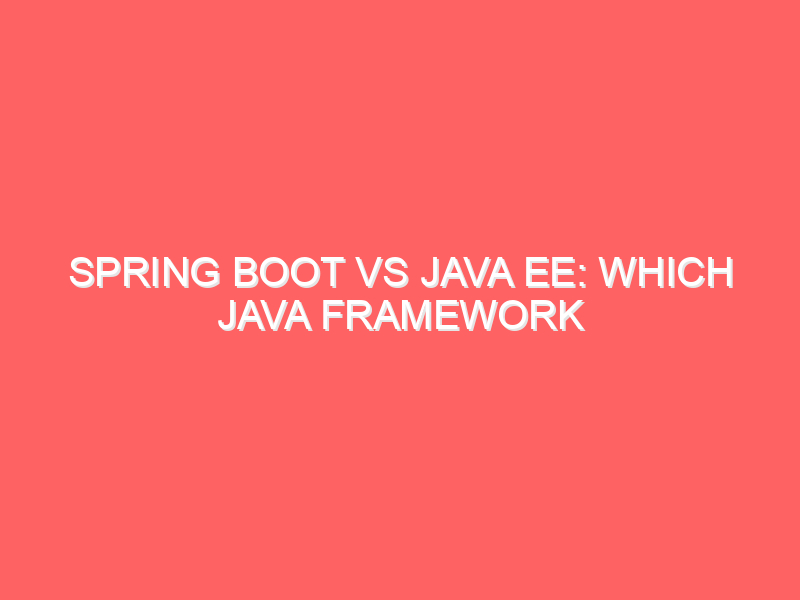In 2025, Java developers have one of the most important decisions to make—Spring Boot vs Java EE. Both are powerful, both are mature, and both are widely used in the enterprise world. But the real question is: which one should you learn in 2025 to build a strong and future-proof career?
In this detailed guide by Emancipation Edutech, we compare Spring Boot vs Java EE in terms of performance, learning curve, ecosystem, job demand, and long-term opportunities.
Understanding the Basics
What is Spring Boot?
Spring Boot is a modern Java framework built on top of the Spring ecosystem. It is known for:
- Rapid development
- Microservice architecture support
- Auto-configuration
- Lightweight and flexible applications
Developers choose it because Spring Boot allows you to build production-ready apps with minimal boilerplate and high scalability.
What is Java EE?
Java EE (Jakarta EE today) is a traditional enterprise framework backed by big vendors. It is:
- Standardized
- Enterprise-focused
- Stable and robust
- Ideal for large-scale enterprise applications
Java EE applications often run on servers like WildFly, Payara, or GlassFish.
Spring Boot vs Java EE: Key Differences in 2025
Choosing between Spring Boot vs Java EE depends on your goals. Let’s break it down category by category.
1. Learning Curve
Spring Boot
- Easier for beginners
- Tons of tutorials, community support
- Auto-configuration reduces complexity
Java EE
- Steeper learning curve
- Harder to set up and configure
- Requires understanding of application servers
Verdict: Spring Boot wins, especially for students and beginners.
2. Development Speed
Spring Boot offers:
- Starter dependencies
- Embedded servers
- Quick packaging as jar/war
- Faster project setup
Java EE:
- Slower initial setup
- More complex configuration
- Better suited for large, enterprise-level systems
Verdict: Spring Boot wins again in 2025 because speed matters in modern development.
3. Performance and Scalability
Spring Boot
- Supports microservices
- Easily scalable using Kubernetes & Docker
- Great for cloud architecture
Java EE
- Designed for monolithic enterprise apps
- Excellent stability and security
- Scales well inside robust enterprise servers
Verdict:
For cloud-native apps → Spring Boot
For pure enterprise monoliths → Java EE
4. Job Market in 2025
Employers in 2025 prefer modern, cloud-ready technologies. A quick look at hiring trends shows:
- Spring Boot jobs dominate global job portals
- Java companies transitioning from Java EE to Spring Boot
- Startups and IT companies prefer microservices → Spring Boot
- Legacy and government projects still rely on Java EE
Result: Spring Boot offers far better job opportunities in 2025.
5. Ecosystem and Community Support
Spring Boot
- Huge community
- Regular updates
- Thousands of extensions
- Backed by VMware (Spring)
Java EE
- Now under Eclipse Foundation
- Slower development pace
- Community is stable but smaller
Verdict: Spring Boot ecosystem is stronger and growing faster than Java EE.
6. Use Cases
Let’s look at real-world scenarios in 2025.
| Use Case | Best Choice |
|---|---|
| Microservices | Spring Boot |
| Cloud-native apps | Spring Boot |
| High-traffic scalable web apps | Spring Boot |
| Banking, insurance, legacy enterprise systems | Java EE |
| Government sector, long-term stability | Java EE |
| Startup or fast-paced product development | Spring Boot |
Spring Boot vs Java EE: Which Should You Learn First?
If you are a student or aspiring developer in 2025, here is the simple guidance:
Learn Spring Boot First
Spring Boot is:
- Fast to learn
- Highly in-demand
- Perfect for microservices
- Cloud-friendly
- Used by modern IT companies
After learning Spring Boot, moving to Java EE becomes easier.
Who Should Learn Java EE?
- Developers working in traditional enterprise companies
- People handling legacy systems
- Those aiming for roles in government or large corporations
But for 90% of learners today, the first choice is Spring Boot.
Why Emancipation Edutech Recommends Spring Boot in 2025
At Emancipation Edutech, we train students based on industry demand, future opportunities, and placement potential.
Our research and collaboration with companies show that:
- Microservices continue to dominate
- Cloud applications require Spring Boot
- Recruiters prefer Spring Boot over Java EE
- Modern IT companies are shifting away from Java EE
So for skill-based career growth, Spring Boot vs Java EE clearly favors Spring Boot.
Final Conclusion: Spring Boot vs Java EE in 2025
Both frameworks have their importance.
- If you want speed, flexibility, cloud-readiness—Spring Boot wins.
- If you want stability and traditional enterprise development—Java EE is still relevant.
But for the average student, beginner, or job seeker in 2025, the best choice is:



